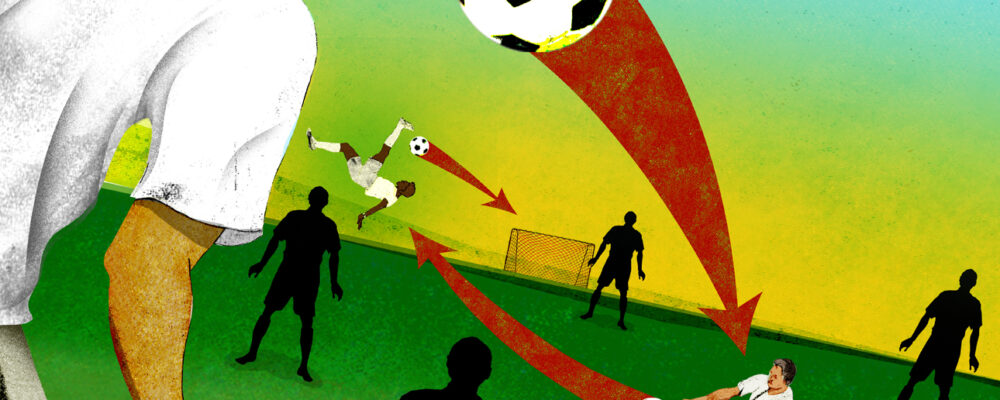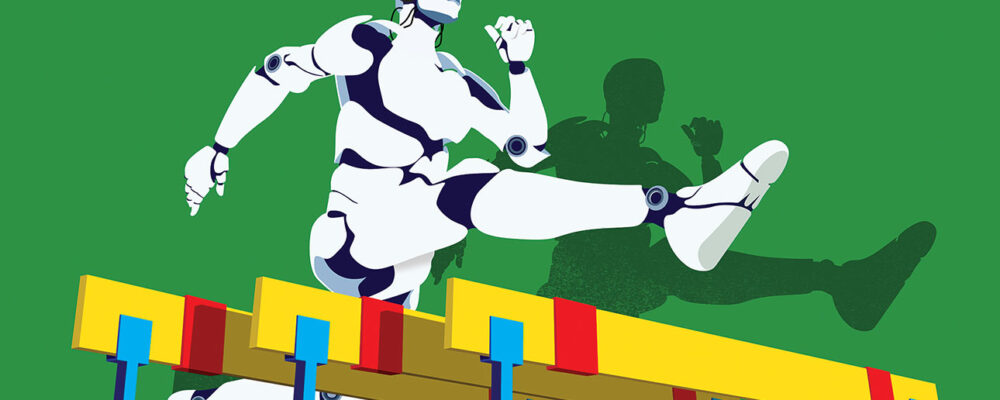Topics
Column
Our expert columnists offer opinion and analysis on important issues facing modern businesses and managers.
More in this series
Paolo Beghini/Ikon Images
On his office door, Clayton Christensen — who at one point I called my teacher, mentor, boss, colleague, coauthor, and, most importantly, friend — had a handcrafted sign saying, “Anomalies Wanted.” Like a good scientist, Christensen believed that the things you didn’t expect provided the richest sources of learning. And indeed, many big changes after 2000 that just feel disruptive don’t quite fit Christensen’s theory of disruptive innovation model.
Lessons from these anomalies — the iPhone, Uber, and Tesla — strengthen our ability to predict the impact of in-process innovations like additive manufacturing and artificial intelligence by showing the importance of expanding our view, getting granular in our analysis, and using multiple models to analyze complex change.
Get Updates on Innovative Strategy
The latest insights on strategy and execution in the workplace, delivered to your inbox once a month.
Please enter a valid email address
Thank you for signing up
Recall the basic idea of disruption, summarized in Christensen’s 1997 blockbuster book The Innovator’s Dilemma: Incumbents generally win when the game is about sustaining innovations that improve along known performance dimensions and lose to upstarts when the game is about disruptive innovations that intentionally trade off performance along traditional dimensions in the name of simplicity, convenience, or affordability.
The driver of disruption is the resource allocation process inside companies. That diffuse, difficult-to-manage process naturally prioritizes innovations that appeal to a company’s best customers. Those customers initially dismiss disruptions because of their limitations, so disruptive innovators take root with customers at the fringes of the market who relish their simplicity and affordability. Since companies innovate faster than people’s lives change, that which is initially not good enough for mainstream customers gets better and better until the disrupter combines good-enough performance with better simplicity and affordability. The market leader, which did everything you are supposed to do, fails in the face of disruptive change.
Anomaly 1: The iPhone
Here’s what Christensen had to say about the iPhone when it launched: “The iPhone is a sustaining technology relative to Nokia. In other words, Apple is leaping ahead on the sustaining curve [by building a better phone]. But the prediction of the theory would be that Apple won’t succeed with the iPhone. They’ve launched an innovation that the existing players in the industry are heavily motivated to beat: It’s not [truly] disruptive. History speaks pretty loudly on that, that the probability of success is going to be limited.”
Whoops.
Christensen would later recant. Why? He said he compared the iPhone to other phones, where he really should have been comparing it to laptop computers. And when you make that comparison, the disruptive nature of the iPhone comes into focus.
The early iPhone certainly had its limitations. Its battery didn’t last long. Typing wasn’t easy. There were only a handful of applications. It had new advantages, such as a cutting-edge internet browser and the kind of radical simplicity that had been Apple’s hallmark for decades. In classic disruptive fashion, the iPhone brought computing to new contexts, where people were delighted with a somewhat limited product.
Also, the iPhone wasn’t just a product play by Apple, it was an ecosystem play. Ron Adner from the Tuck School of Business at Dartmouth College has deeply studied ecosystems in his books The Wide Lens and Winning the Right Game. His research shows how innovation success requires smartly thinking about how to work with suppliers, channels to market, complementary industries, and more. That’s one reason, he argues, that Amazon’s e-reading platform Kindle crushed Sony’s e-reader. Even though Sony’s reader was technologically more sophisticated, Amazon made it incredibly easy to obtain content, making its device significantly more usable.
In classic disruptive fashion, the iPhone brought computing to new contexts, where people were delighted with a somewhat limited product.
Similarly, the full power of Apple’s disruption only became apparent about a year after the iPhone launched. While the elegance of its design captivated reviewers and early adopters, early sales weren’t that great. The browser was cool, but slow networks limited its functionality, and Apple did not allow third-party developers to create applications for the iPhone. Why would it need to? “What’s the killer app?” Steve Jobs said at the iPhone’s launch in January 2007. “The killer app is making calls. It’s amazing how hard it is to make calls on most phones.”
If you were Nokia, Research in Motion, Motorola, Palm, Handspring, or Ericsson, maybe you took solace in the iPhone’s slow start. By the end of 2007, however, Jobs changed course, and it shouldn’t have really been a surprise. When Apple’s iPod music player first came out, it was limited because it seamlessly worked only with Apple’s Mac computers. Then, when Apple ported iTunes to Windows-based computers, the product took off. Jobs had demonstrated that he was willing to be … flexibly controlling.
This time, Jobs announced that Apple would have a software development kit for third-party apps within four months. And the rest is history. In 2023, the App Store generated close to $100 billion in revenues for Apple. By way of comparison, The Coca-Cola Co. earns approximately $50 billion a year in revenue. Think about that the next time you start playing a silly game on your phone.
The anomaly of the iPhone teaches us to expand our view in three ways. First, think carefully about the comparison set. What job does a customer hire an innovation to get done? What else could it hire to get that job done? Second, zoom out to look at the broader ecosystem. Does the innovation change industry dynamics in a broader way? Finally, don’t just look at the snapshot of an innovation at a given time; watch the full movie and be flexible as a company’s full strategy comes into full focus.
Anomaly 2: Uber
Analyzing innovation has gotten harder as the world has gotten more complicated.
The iPhone was a combination of many innovations. When it launched, you could focus on its multi-touch interface, how it ported the Macintosh operating system onto a handheld device, the uniqueness of its web browser, the power of its camera, the Gorilla Glass screen, its unique partnership with Google, and on and on and on. It’s increasingly hard to say a company is or isn’t following a disruptive path, because a company’s product or service combines so many different facets.
Take one of the weirdest podcasts I have ever been on as part of a panel of disruptive experts. It was the 15th episode of The Disruptive Voice, created by the Forum for Growth and Innovation, a group at Harvard Business School that helped to augment Christensen’s research. Titled “Is Uber Disruptive?” it was 36 minutes long.
That’s a long time to answer what seems self-evident, as saying that Uber was categorically not disruptive would seem to require significant logical and theoretical contortions. Yet, parts of Uber seemed anomalous. In a December 2015 Harvard Business Review article, Christensen and coauthors Rory McDonald and Michael Raynor wrote, “The theory of disruption predicts that when an entrant takes the incumbent competitors head-on, offering better products or services, the incumbents will accelerate their innovations to defend their business.”
Evaluating Uber requires a multidimensional analysis. Is the customer the person seeking to get from point A to point B? Or is it the driver, who wants to get compensated for getting the person from point A to point B? And how do you think about the difference between Uber, UberX, UberX Share, Uber Black, Uber Eats, and so on? And how does the reality that the taxicab industry is fragmented and generally horrifically run factor in?
Taking Uber apart and looking at each of these components leads to the clear conclusion that some pieces of it squarely fit the original disruptive model, and some pieces don’t. While the “incumbents” would increase their investment to defend their position, fragmented local competitors couldn’t compete against a global company with significant venture capital backing.
The lesson? Get granular. Pick an innovation apart. Consider how it creates, captures, and delivers value. Look at the competitive set. Are there factors that could inhibit or enhance your ability to respond to new competition?
Anomaly 3: Tesla
Disruption purists look at Tesla with skepticism. Disruption starts with simple solutions at the low end of the market, or in new contexts. Tesla started with a premium-priced sophisticated solution. Yet, it seems to have played out in a disruptive way with market leaders struggling to respond.
Tesla highlights the importance of avoiding overreliance on a single, relatively simple model, as tempting as it might be. The real world is a complicated place. A powerful model or framework is useful, but it is always important to remember that the world of business is not Newtonian physics. Stuff happens. Tesla, for example, got hundreds of millions of dollars from the U.S. government in 2010, when it was still a young company (it repaid the loan in 2013). And then governments around the world gave ample tax credits to people who bought electric vehicles. A single model struggles to make sense of the real world’s complexity.
I recommend using a combination of models to make the best predictions possible, be clear about assumptions, and identify what you would see that indicates your prediction was wrong. And, critically, be happy with being wrong.
Tesla highlights the importance of avoiding overreliance on a single, relatively simple model, as tempting as it might be.
There are undoubtedly some disruptive elements to Tesla. Its cars offer new benefits, of course, but drivers have to wait for it to charge and suffer from the dreaded range anxiety. A range of models beyond disruption help to explain why incumbent car manufacturers have struggled to respond. Beyond Adner’s ecosystem frame, a seminal 1990 paper by Rebecca Henderson and Kim Clark (which influenced Christensen’s research) demonstrated that market leaders struggled with “architectural” innovations that changed the way they interacted internally, even if the technology was trivial.1 Electrification certainly has architectural components, helping to explain the challenges of incumbent response.
Another useful lens comes from the systems psychodynamics world. The research of scholars such as Gianpiero Petriglieri and Susan Long shows that groups create powerful defense mechanisms when they feel threatened.2 Moving from a mechanical engineering mindset to a software mindset is exactly the kind of threat that triggers those defense mechanisms. Even if top leaders make big resource allocation decisions, those defense mechanisms make change incredibly challenging.
A good strategist has multiple arrows in their quiver. To augment my own understanding of disruptive change, I try to keep up with relevant literature in a range of fields, most notably strategy, innovation, leadership, organizational behavior, systems psychodynamics, and behavioral psychology. Each of those lenses provides unique insight into a rich, complex challenge.
Apple, Uber, and Tesla all led to results that matched those of disruptions detailed in The Innovator’s Dilemma, but didn’t quite fit Christensen’s original model. That’s OK. The anomalies have taught us to carefully consider the comparison set, evaluate the ecosystem, unpack an innovation, and use alternative frameworks. Anomalies wanted, indeed.
References
1. R.M. Henderson and K.B. Clark, “Architectural Innovation: The Reconfiguration of Existing Product Technologies and the Failure of Established Firms,” Administrative Science Quarterly, 35, no. (1) (1990): 9-30.
2. G. Petriglieri and J.L. Petriglieri, “The Return of the Oppressed: A Systems Psychodynamic Approach to Organization Studies,” Academy of Management Annals 14, no. (1) (2020): 411-449.
“The MIT Sloan Management Review is a research-based magazine and digital platform for business executives published at the MIT Sloan School of Management.”
Please visit the firm link to site






